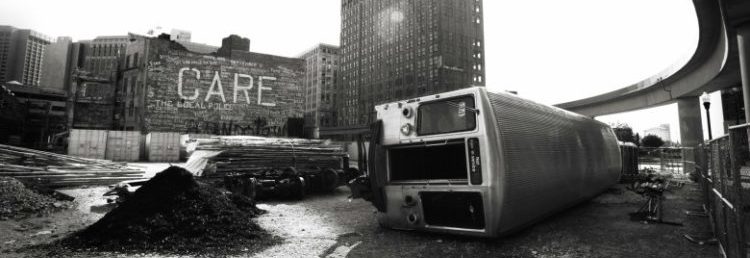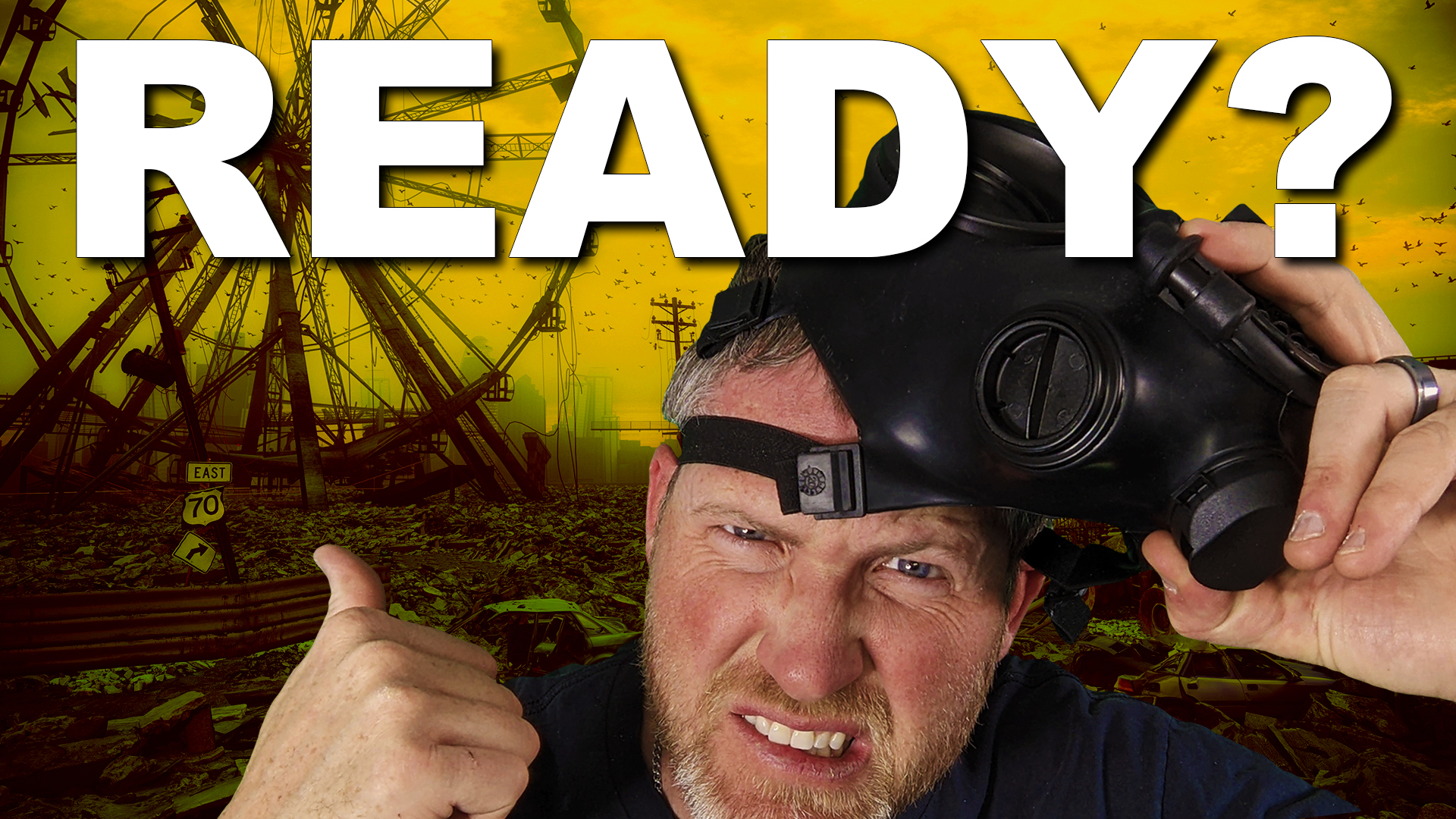
At first, there were riots.
Now the city’s been dark for months.
There’s no indication things are going to improve anytime soon.
Roaming street gangs have formed and stolen everything of practical value in this harsh new world.
Roadblocks are everywhere.
The few vehicles that still run are either gunned down in the street as someone tries to escape or stolen as the gangs make their rounds.
Movement is what keeps me alive.
I travel light and only on foot during periods of low light. Each day is becoming more difficult to find food, and this life on the move is hard on me.
There are quiet whispers of a community 200 miles outside of this hellish city working together to survive.
The squeeze on resources has choked life out of this city.
It’s time to escape…
Are You Ready For The Tough Times Ahead? Take My 60 Sec Quiz To See If You’re Part Of ‘The Fragile Masses’ Or Not… Start Quiz Now!
Urban Escape and Evasion: Decision Time
Our society is a thin veneer that, when stripped away, will force us to make hard decisions for ourselves, our families, and our communities. There are no hard, fast answers in any incident.
Adaptation is not a checklist.
The skill sets we obtain before the hammer drops are a huge determinant of how and if we survive.
The scope of this article is not to provide guidance on when to bug out or remain in place but rather focus on tactics, techniques, and procedures for operating in and evading the urban environment.
According to The Guardian, nearly 85% of the US population lives in a city, so odds are – this affects you.
How to Survive the First 90 Days After the Collapse
Ride It Out Or Leave?
It’s safe to say most Americans plan to ride out most catastrophes at home.
They’ve spent a lifetime accumulating ‘stuff’ and will not leave it behind. This is especially true for those who have planned ahead and stockpiled food and equipment.
There are exceptions to every rule, like when an incident is localized (such as a natural disaster) and options for temporarily relocating exist. In this situation, the ‘stay behind’ crowd can be convinced to evacuate for the short term.
In many cases, bugging in makes the most sense.
You have shelter, at least some food/water, all the equipment and materials you’ve stockpiled thus far, and a known location with a baseline understanding of your neighbors and their behaviors.
Additionally, you cannot travel outside your immediate location to meet your needs. Simply put, you’re not trading the ‘known’ for the ‘unknown.’
5 Critical Urban Survival Skills to Learn Now
This is probably a good time to introduce the PACE acronym.
Primary, Alternate, Contingency, Emergency (PACE) Plan
Even the most stubborn folks in the ‘ride it out’ clan need a PACE plan.
The military has used this since the dawn of time because we know better than anyone that plans rarely survive first contact.
PACE is just a way to have three backup plans built-in.
With that said, planning needs to occur at each level. Don’t just list a backup to fill in the blank. Plan out the What/Where/When/Who/Why/How.
It may look something like this:
- P – Bug in a home (working together with neighbors)
- A – Bug out to a nearby friend’s house (suburbs?)
- C – Bug out to location X (family or friends in a rural setting)
- E – Bug out to location Y (family or friends in a more distant rural setting)
A Green Beret Explains PACE Planning
As A Way To Introduce You To Skilled Survival, We’re Giving Away Our Ultimate Survival Gear Checklist. Click Here To Get Your FREE Copy Of It.
Strength In Numbers
There are obvious advantages to working in groups in times of crisis. This is why our ancestors weren’t a bunch of lone wolves.
Even the bad guys figure this out pretty quickly and form gangs. To give you an idea of the benefits, here are a few:
- Improved security (more guns and a legitimate watch schedule that actually allows you to sleep while your neighbor watches your back)
- Improved food procurement (whether gardening or hunting, the pack mentality is a force multiplier)
- Reduced duplication of tasks/resources (pulling security for a crew of 20 is just about as easy as pulling it for only your family)
- Specialization (you might be awesome at gardening, while your neighbor is a nurse. You get medical care, and she gets to eat)
- Mass (lots of defenders can ward off lots of attackers)
You get the idea. Aristotle said it best,
“The whole is greater than the sum of its parts”.
One key to a successful group is the speed of its organization.
If you’ve established a tribe and the roles within (prior to a disaster), your chances of survival and preventing conflict within the group improve exponentially.
Urban Escape and Evasion: The Catalyst
A good place to start this dialog with your neighbors today is by starting or joining the neighborhood watch.
Even those that are not “preppers” understand that sects of society target the affluent. Crime is real, and every class of society is at risk.
Once you begin working with your neighbors in this capacity, you’ll better understand their capabilities, specialization, commitment level, personality, and resources. This opens the door and facilitates the formation of a tribe.
A good tribe means a better quality of life daily and certainly when the chips are down. Probably one of the reasons ‘Love thy neighbor’ ranked so high in the Ten Commandments!
The rise of social media allows people to have thousands of connections to friends and co-workers, but it’s a double-edged sword. Many of us have lost the real connection with the people next door.
Don’t worry, though; there’s an app for that too. Check out Nextdoor – it’s a free private social network for your neighborhood.
Today, some folks find it easier to make connections this way instead of just shaking hands across the fence. So get started building your tribe today. Otherwise, you may have to head for the hills when the balloon goes up.
Escape the City
Regardless of the reason, one may have to bug out in a hostile environment.
Escaping the city early into the disaster may allow you to use a vehicle, whereby the complexity and time required for escape are vastly reduced.
For the purposes of this article, we’re going to assume vehicles are not an option, and we’ll dig into the factors that affect travel on foot.
Pre-crisis planning for the urban environment starts with an in-depth knowledge of the local area. If you are escaping a city you live in, you have the advantage over an evader escaping a ‘foreign’ city where they don’t know the terrain or the people. Some important areas for pre-planning include:
Habits, customs, taboos, clothing, and general appearance of local personnel.
These factors help the evader understand if blending in is possible, how to carry it out, and the risks associated with disguise.
- What does your full bug-out system look like?
- Will the clothing raise questions (like a ghillie suit in a city)?
- Is your pack covered in MOLLE webbing going to draw unwanted attention?
- How will you carry your weapon?
How the Unprepared Will Act After SHTF
As A Way To Introduce You To Skilled Survival, We’re Giving Away Our Ultimate Survival Gear Checklist. Click Here To Get Your FREE Copy Of It.
 Survival, Evasion, Resistance, and Escape
Survival, Evasion, Resistance, and Escape
In SERE (Survival, Evasion, Resistance, and Escape), we always say to assume the enemy’s presence.
The urban evader is wise to heed this warning as there are likely elements present that intend to do him harm, and they might look no different than other members of the community.
Therefore, all personnel should be avoided if possible.
Depending on the circumstances of the crisis, evaders also need to be cognizant of the following hazards:
- Checkpoints, control zones, and any border-type areas
- Police, military areas, and prisons
- Churches, markets, schools, and food distribution points
- Rationing, curfews, and civilian roundups
Other dangers in a compromised urban environment include debris, falling rubble, collapsing walls, contaminants, polluted water, gas leaks, downed power lines, and booby traps.
Mind fields are even a possibility depending on the duration and cause of the crisis.
At the risk of beating a dead horse, I want to go into a little more detail on how dynamic and dangerous the urban environment is so that you’ll understand the extremely complex and layered challenged urban operations present.
To gain a greater understanding of the planning and situational awareness required, here’s how we break down the three-dimensional space:
- Urban airspace
- Super-surface (tops of a building)
- Intra-surface (interior of buildings)
- Surface (ground, street, and water level)
- Sub-surface (underwater and subterranean)
At all these levels, threats are not only possible but likely. Feeling surrounded, yet? Good, you’re starting to grasp the severity.
Don’t worry; there are techniques that you can use to your advantage.
SERE training What You Need to Know About the Course” width=”500″ height=”281″ src=”https://www.youtube.com/embed/IvAOKoXP1tg?feature=oembed” frameborder=”0″ allow=”accelerometer; autoplay; clipboard-write; encrypted-media; gyroscope; picture-in-picture; web-share” allowfullscreen sandbox=”allow-scripts allow-same-origin”>

Urban Escape and Evasion Techniques

Adaptability is the key to successful urban escape and evasion, especially in the urban environment.
Hiding in urban structures, evading plain sight in disguise, and using three-dimensional space during movement are a few examples.
Immediate Action Using Initial Movement
Evaders must have a pre-determined course of action and execute that plan without pause. Remember your PACE plan? It’s time to put it into action.
Your gear needs to be ready to go.
Movement is life, so any delay is a detriment. Use environmental or situational aids for concealment. Darkness, inclement weather, dust, smoke, haze, ground cover, and any combat action will help provide opportunities.
All movements should be irregular to prevent enemies from anticipating your movement and setting up an ambush. Radically change direction, often using hook-backs, deliberate offsets, and erratic patterns with the intended line of travel.
If you’re breaking contact from some immediate threat, speed is essential. The main objective of this phase of the movement is to put time, distance, and terrain between you and the enemy/location without being compromised.
Take advantage of any “green spaces” in the city, like parks, golf courses, or cemeteries, as these will usually offer more concealment options, lower population densities, and water procurement options.
Exclusive Bonus Content – Skilled Survival’s 104 Item Bug Out Bag Checklist – the only bug out checklist worth using. Click Here To Get Your FREE Copy Of It.
Hole Up/Hide Site
During movement, evaders must utilize hole-up sites to rest, plan, regroup, hide from the enemy or a combination of these reasons. When selecting a hole-up site, use the PIC acronym:
- Protection from the environment
- Invisibility from the enemy
- Comfort – for quality rest/morale
Your site needs to offer multiple escape routes, and prior to entering, use a wide sweeping J-hook approach to allow you early warning of any trackers following your trail.
Avoid hiding sites that are in obvious locations or where there is a high degree of contrast. Structures used as hole-up sites are possible, but unoccupied areas are preferable.
Here are a few ideas to start: Derelict buildings, sheds, factories, garages, ruins, rubble, subterranean areas, dumps, shops, churches, and alleys.
Once you’ve found the ideal area, identify a specific location in the structure for the actual site. Attics, basements, rooftops, steep slopes, between walls, under floors, and crawl spaces are your bread and butter for “hide sites.”
Depending on the threat, terrain, and time available, the evader should use multiple sites rotating between each one. This prevents a ‘lived-in’ look and makes it hard for the enemy to identify a pattern.
Evasion Movement
Evaders must determine the type of evasion appropriate for the environment. The threat and sociopolitical factors will dictate this.
In some cases, they may need to avoid any contact with the locals (moving from the point of concealment to the next point of concealment). Other situations may permit the use of disguise during movement.
If contact occurs, the idea is to be perceived as local. During this type of movement, the evader must ensure their efforts are not out of place or suspicious. There are three categories of people an evader should pattern themselves after:
- Untouchables – homeless, or those generally avoided or ignored
- Invisibles – janitorial, delivery, utility personnel (part of the scenery)
- Grayman – looking/acting like everyone else (mirroring)
No matter if you are using disguise or avoiding the locals entirely, here are some additional factors that need to be considered during movement phases:
- Observe the area several hours prior to leaving hide sites
- Use the time of day that will be the least noticeable
- Stay low to minimize signature
- Travel near battle-damaged areas and use clutter in streets and alleys to your advantage
- Avoiding intact buildings
- Use structures, rubble, clutter, foliage, or ditches for terrain masking
- Learn how to pick a door lock to access secure buildings
Urban Bugout – Part 1
Urban Bugout – Part 2
Exclusive Bonus Content – Skilled Survival’s 104 Item Bug Out Bag Checklist – the only bug out checklist worth using. Click Here To Get Your FREE Copy Of It.
Improvising
One vital component of successful urban escape and evasion is the ability to improvise to meet your needs.
Evaders must be extremely resourceful in using items found in their surroundings. Here’s a quick snap-shot of ideas for meeting needs in the urban environment:
- Water – found in spigots, hoses, pipes, water heaters, toilet tanks, rain barrels, or downspouts during rain (purify all before consumption).
- Food – scavenged canned goods, fresh trash, squirrels, rats, pigeons, fruit/nut trees, or even pets.
- Clothing – stolen/discarded, improvised from cloth upholstery, curtains, survival blankets, or trash bags.
- Insulation – stuffing from furniture, foam rubber, paper, or cardboard.
- Diversion safes – keep any valuables well-hidden at all costs.
Urban Survival: Improvised Shelter During SHTF
Urban Escape and Evasion Navigation
One can employ a few techniques during the initial planning stages and while navigating their way out of the city. Evaders should use recognizable landmarks like stadiums, cemeteries, statues, prominent buildings (towers, churches, etc.), bridges, and natural features (rivers, mountains, cliffs, etc.).
These known landmarks can help maintain a reference point during travel.
Other urban landmarks like satellite dishes (pointing south) or patterned street names/numbers or addresses can give navigational clues.
Avoid obvious behaviors such as pulling out a map, compass, or GPS if evading using a disguise.
Any repetitious motion can draw unwanted attention.






 Survival, Evasion, Resistance, and Escape
Survival, Evasion, Resistance, and Escape

